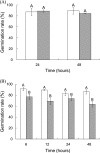Inactivation of Escherichia coli O157:H7 on radish seeds by sequential treatments with chlorine dioxide, drying, and dry heat without loss of seed viability
- PMID: 21803896
- PMCID: PMC3187125
- DOI: 10.1128/AEM.05715-11
Inactivation of Escherichia coli O157:H7 on radish seeds by sequential treatments with chlorine dioxide, drying, and dry heat without loss of seed viability
Abstract
We developed and validated a treatment to inactivate Escherichia coli O157:H7 on radish seeds without decreasing seed viability. Treatments with aqueous ClO(2) followed by drying and dry-heat treatments were evaluated for efficacy to inactivate the pathogen. Conditions to dry radish seeds after treatment with water (control) or ClO(2) were established. When treated seeds with high water activity (a(w)) (>0.99) were stored at 45°C and 23% relative humidity (RH), the a(w) decreased to <0.30 within 24 h. Drying high-a(w) seeds before exposing them to dry-heat treatment (≥60°C) was essential to preserve seed viability. The germination rate of radish seeds which had been immersed in water for 5 min, dried at 45°C and 23% RH for 24 h, and heated at 70°C for 48 h or at 80°C for 24 h was not significantly decreased (P ≤ 0.05) compared to that of untreated radish seeds. Sequential treatments with ClO(2) (500 μg/ml, 5 min), drying (45°C, 23% RH, 24 h), and dry heating (70°C, 23% RH, 48 h) eliminated E. coli O157:H7 (5.9 log CFU/g) on radish seeds and, consequently, sprouts produced from them without decreasing the germination rate. These sequential treatments are recommended for application to radish seeds intended for sprout production.
Figures


Similar articles
-
Reduction of Escherichia coli O157:H7 on radish seeds by sequential application of aqueous chlorine dioxide and dry-heat treatment.Lett Appl Microbiol. 2011 Oct;53(4):424-9. doi: 10.1111/j.1472-765X.2011.03125.x. Epub 2011 Aug 15. Lett Appl Microbiol. 2011. PMID: 21770990
-
Combined effects of chlorine dioxide, drying, and dry heat treatments in inactivating microorganisms on radish seeds.Food Microbiol. 2011 Feb;28(1):114-8. doi: 10.1016/j.fm.2010.09.002. Epub 2010 Sep 16. Food Microbiol. 2011. PMID: 21056782
-
Inactivation of Escherichia coli O157:H7 on radish and cabbage seeds by combined treatments with gaseous chlorine dioxide and heat at high relative humidity.Food Microbiol. 2021 Oct;99:103805. doi: 10.1016/j.fm.2021.103805. Epub 2021 Apr 17. Food Microbiol. 2021. PMID: 34119098
-
Sanitizing radish seeds by simultaneous treatments with gaseous chlorine dioxide, high relative humidity, and mild heat.Int J Food Microbiol. 2016 Nov 21;237:150-156. doi: 10.1016/j.ijfoodmicro.2016.08.022. Epub 2016 Aug 18. Int J Food Microbiol. 2016. PMID: 27569378
-
Applications of dry chain technology to maintain high seed viability in tropical climates.PeerJ. 2024 Oct 11;12:e18146. doi: 10.7717/peerj.18146. eCollection 2024. PeerJ. 2024. PMID: 39403193 Free PMC article. Review.
Cited by
-
A new in vitro monitoring system reveals a specific influence of Arabidopsis nitrogen nutrition on its susceptibility to Alternaria brassicicola at the seedling stage.Plant Methods. 2022 Dec 8;18(1):131. doi: 10.1186/s13007-022-00962-3. Plant Methods. 2022. PMID: 36482365 Free PMC article.
-
Characterization of Efficiency and Mechanisms of Cold Atmospheric Pressure Plasma Decontamination of Seeds for Sprout Production.Front Microbiol. 2018 Dec 19;9:3164. doi: 10.3389/fmicb.2018.03164. eCollection 2018. Front Microbiol. 2018. PMID: 30619223 Free PMC article.
References
-
- Bang J., Kim H., Kim H., Beuchat L. R., Ryu J.-H. 2011. Combined effects of chlorine dioxide, drying, and dry heat treatments in inactivating microorganisms on radish seeds. Food Microbiol. 28:114–118 - PubMed
-
- Bang J., et al. 2011. Reduction of Escherichia coli O157:H7 on radish seeds by sequential application of aqueous chlorine dioxide and dry heat treatment. Lett. Appl. Microbiol. [Epub ahead of print.] doi: 10.1111/j.1472-765X.2011.03125.x - DOI - PubMed
-
- Bari M. L., Nei D., Enomoto K., Todoriki S., Kawamoto S. 2009. Combination treatments for killing Escherichia coli O157:H7 on alfalfa, radish, broccoli, and mung bean seeds. J. Food Prot. 72:631–636 - PubMed
-
- Bari M. L., Nazuka E., Sabina Y., Todoriki S., Isshiki K. 2003. Chemical and irradiation treatments for killing Escherichia coli O157:H7 on alfalfa, radish, and mung bean seeds. J. Food Prot. 66:767–774 - PubMed
-
- Beuchat L. R. 1997. Comparison of chemical treatments to kill Salmonella on alfalfa seeds destined for sprout production. Int. J. Food Microbiol. 34:329–333 - PubMed
Publication types
MeSH terms
Substances
LinkOut - more resources
Full Text Sources
Molecular Biology Databases

